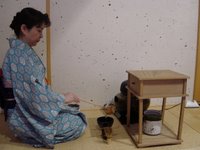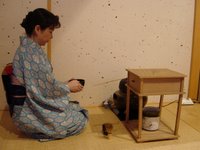April 18, 2006
April 12, 2006
April 11, 2006
April 08, 2006
Vlog Map
 Hello Videobloggers -- We're on the map! Click here to go to the global Vlog Map and find Shintani's Vlog.
Hello Videobloggers -- We're on the map! Click here to go to the global Vlog Map and find Shintani's Vlog.
April 06, 2006
Broeckmann war da
 Andreas Broeckmann gave a lecture and an exclusive interview in Stuttgart on 5 April -- review coming soon. As background, you can read my review of the Transmediale 05, which appeared in Computer Music Journal.
Andreas Broeckmann gave a lecture and an exclusive interview in Stuttgart on 5 April -- review coming soon. As background, you can read my review of the Transmediale 05, which appeared in Computer Music Journal.
April 05, 2006
April 04, 2006
Am. Music -- Chinaman, Laundryman
Recently on Orchestra List, a Yahoo group, a lister wrote, "The current furor over immigration got me thinking - dangerous, I know. I'd like to put together an educational concert featuring music of America's 'immigrants.'"
 I suggest Ruth Crawford Seeger's Chinaman, Laundryman for voice and piano, written in 1932. 30 seconds can be heard on emusic.com (look for track nr. 8).
I suggest Ruth Crawford Seeger's Chinaman, Laundryman for voice and piano, written in 1932. 30 seconds can be heard on emusic.com (look for track nr. 8).
April 03, 2006
What Is Music? Samite
 Samite and Uganda
African children who have been forced to kill as soldiers are not a lost generation, according to Ugandan musician Samite.
Samite and Uganda
African children who have been forced to kill as soldiers are not a lost generation, according to Ugandan musician Samite.
April 01, 2006
Tea Lesson 2
Sokei Kuno: Fukusa sabaki
On wabi-sabi:
"It is difficult to define the two concepts of sabi and wabi unambiguously, since in their deepest sense they have to be felt rather than cognized.
‘It shows taste to tie up a noble courser in front of a thatched hut’ – this saying of Shuko’s contains both sabi and wabi.
The picture of a simple, thatched hut, preferably standing by itself amid a winter landscape, conveys to us the concept wabi. And a noble stallion tied up to, or in front of, this simple, lonely hut is sabi.
Not only does this aesthetic ideal embrace a mere simple beauty, but it has to be a beauty containing within itself the wabi feeling – a dark, subdued, yet pregnant beauty, the beauty of maturity.
Sabi is characterized by the absence of obvious beauty, by the beauty of the colorless as opposed to the resplendent, by the beauty of the perishable as against the exuberantly active. The concept sabi, then, carries the meaning of ‘aged’ in the sense of ‘infused with the patina which lends old things their beauty’ – but also tranquility, aloneness, deep solitude.
Taking this together with a pronouncement of the Yamanoe no Soji ki, we can begin to appreciate the ultimate goal of the ideal in question: ‘If a person has become a Grand Master of the Tea Ceremony and still possesses only one kind of tea utensil, this, to a wabi devotee, amounts to total perfection.’ Here, then, once again, the right attitude is seen as proceeding from the heart.
We can here detect the first appearance of the ‘imperfect’ in the Tea Ceremony. And this concept is likewise central to the Tea Way as a whole. But there is even more to the concept wabi than this. It involves the recognition of the limits of human will in the face of the universe, the respecting of one’s fellow-man as one sentient being among an infinite number of sentient beings, together with self-moderation and the will to self-effacement."
Excerpted from Zen in the Art of the Tea Ceremony by Horst Hammitzsch, ©1958, ISBN 090654002X (pp. 45-6).
 Inspecting the hishaku
Inspecting the hishaku
 Pouring water
Pouring water
 Warming the Ochawan (tea bowl)
Warming the Ochawan (tea bowl)
